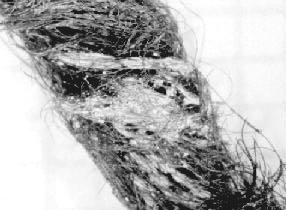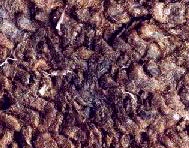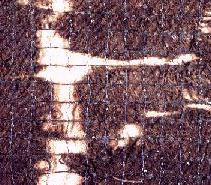CAN DECAYED FIBRES BE STRENGTHENED?
Textile fibres lose cohesion when they decay. The long fibres that are
spun into yarn break into shorter pieces and collapse into dust at a touch.
Many impregnants have been tried over the years in attempts to hold the
fibres intact. Many of them give the fibres a wet and sticky appearance
and they are difficult to remove without damaging the fibres.
Today, we sometimes use water soluble consolidants together with freeze
drying. The textile is sometimes given a very weak lanolin treatment if
it seems very brittle.
 In
the 1930's Conservator Rosenberg found,
after many trials, an impregnation treatment with Chinese Wood Oil dissolved
in turpentine. This has penetrated like a lacquer and matted the fibres
together. In 1992 we tried to remove the oil with an enzyme, with the result
that the oil liquified and penetrated even deeper between the yarn fibres.
Only vigorous washing, which would have damaged the textile, could have
removed the oil.
In
the 1930's Conservator Rosenberg found,
after many trials, an impregnation treatment with Chinese Wood Oil dissolved
in turpentine. This has penetrated like a lacquer and matted the fibres
together. In 1992 we tried to remove the oil with an enzyme, with the result
that the oil liquified and penetrated even deeper between the yarn fibres.
Only vigorous washing, which would have damaged the textile, could have
removed the oil.


Attempts were made in the 1960's to strengthen fibres
with synthetic impregnants, soluble nylon for example. The surface of the
textile on the left is now rubbery and the soluble nylon is no longer soluble.
The picture to the right is untreated textile from the same site at Lønne
Hede (both pictures 2cm across)
SUPPORT
Textiles need support so that they can be stored or exhibited without
damage. In earlier times small fragments were compressed between two glass
plates. Larger fragments of costumes and blankets were often glued to a
supporting silk net or sewn onto a support fabric.
Today we frame fragments or lay them in boxes of acid-free cardboard.
Glues are no longer used. Sewing to a support is used only when it is judged
necessary for an exhibition. We prefer to exhibit textiles so that they
are supported without being held fast.
 Textile
glued to silk net. The net is not very durable. It decomposes, leaving
only glue on the original (silk mesh size is 5mm).
Textile
glued to silk net. The net is not very durable. It decomposes, leaving
only glue on the original (silk mesh size is 5mm).
 Textile
sewn to a backing cloth. This is the back side of the dress shown in the
first illustration. It is a find from the Norse settlements in Greenland,
about 1400. The backing cloth has now faded so that the colour no longer
matches the object. Nowadays we would choose a backing cloth with similar
appearance to the original. More light resistant dyes would be used for
colouring the backing cloth.(detail 25cm across)
Textile
sewn to a backing cloth. This is the back side of the dress shown in the
first illustration. It is a find from the Norse settlements in Greenland,
about 1400. The backing cloth has now faded so that the colour no longer
matches the object. Nowadays we would choose a backing cloth with similar
appearance to the original. More light resistant dyes would be used for
colouring the backing cloth.(detail 25cm across)
Earlier, the stitching to the backing cloth was made with a thick woollen
yarn. Nowadays we would use a thin thread that can be removed without causing
damage to the textile.
On to the next section...
 In
the 1930's Conservator Rosenberg found,
after many trials, an impregnation treatment with Chinese Wood Oil dissolved
in turpentine. This has penetrated like a lacquer and matted the fibres
together. In 1992 we tried to remove the oil with an enzyme, with the result
that the oil liquified and penetrated even deeper between the yarn fibres.
Only vigorous washing, which would have damaged the textile, could have
removed the oil.
In
the 1930's Conservator Rosenberg found,
after many trials, an impregnation treatment with Chinese Wood Oil dissolved
in turpentine. This has penetrated like a lacquer and matted the fibres
together. In 1992 we tried to remove the oil with an enzyme, with the result
that the oil liquified and penetrated even deeper between the yarn fibres.
Only vigorous washing, which would have damaged the textile, could have
removed the oil.


 Textile
glued to silk net. The net is not very durable. It decomposes, leaving
only glue on the original (silk mesh size is 5mm).
Textile
glued to silk net. The net is not very durable. It decomposes, leaving
only glue on the original (silk mesh size is 5mm).
 Textile
sewn to a backing cloth. This is the back side of the dress shown in the
first illustration. It is a find from the Norse settlements in Greenland,
about 1400. The backing cloth has now faded so that the colour no longer
matches the object. Nowadays we would choose a backing cloth with similar
appearance to the original. More light resistant dyes would be used for
colouring the backing cloth.(detail 25cm across)
Textile
sewn to a backing cloth. This is the back side of the dress shown in the
first illustration. It is a find from the Norse settlements in Greenland,
about 1400. The backing cloth has now faded so that the colour no longer
matches the object. Nowadays we would choose a backing cloth with similar
appearance to the original. More light resistant dyes would be used for
colouring the backing cloth.(detail 25cm across)